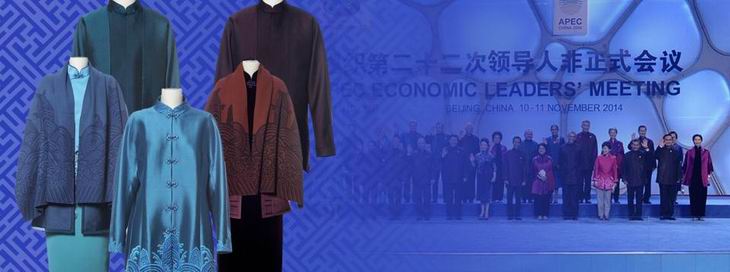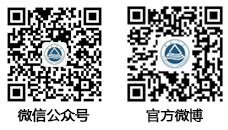At the Asia-Pacific Economic Cooperation (APEC) ceremony, all participant state-leaders and their spouses gathered for “family photo” in traditional Chinese-style costumes, whose design impressed the world and sparked hot discussions among global media. It has been widely reported that Song brocade, the costume fabric, was manufactured in Suzhou. However, few know the fact that multiple elements of the costume came from the design ideas of JU’s faculty members.
“3 Rounds” awaiting design schemes; Dinner dresses unveiled
According to Professor Cui Rongrong from School of Textile & Clothing at JU, first-phase scheme collection for the costume design of the APEC leaders’ began in late December, 2013. “A total of 71 enterprises, 259 designers and 18 institutions of higher learning received the design invitations.”
It takes “3 Rounds” stages from design scheme to formal costume. On the first stage, it was required to submit design drawings. “Through the first round review, 60 works were qualified for the next step--garment making, including four designs from two work teams at JU.” After completing the ready-made garments, the design teams would be reviewed in the ways of on-the-spot defence in Beijing by an assessing panel for the second-round evaluation. “Among them, 17 conference dresses and 18 dinner dresses were chosen as samples including several entries from JU.” In his words, the selected designs were equivalent to a database for the final version of APEC leaders’ costume design. On the last stage, the design was finalized with an in-depth design based on the integration of the outstanding elements in the 35 works by a specialized design group.
As Professor Cui said, during the APEC summit, the Chinese-style costume only unveiled the party dresses. In replacement of the originally arranged conference dresses, leaders all appeared in suits for conferences. “What we saw in the “family photo” belongs to party dresses category in the design scheme.”
Fabric of jacquard swastika, color scheme of fuchsia and “sea and hills” pattern were all put forward by JU
“The main idea in our design scheme was using Song brocade as the costume fabric.” said Professor Cui. Song brocade is a state-level non-material cultural heritage which began to use in the Song Dynasty. Due to the fact that hand-made brocades take too much time, the teams didn’t decide to adopt Song brocade until they knew that an enterprise in Suzhou had mastered industrialized manufacturing techniques for Song brocade. The “computer-controlled jacquard weaving” technology was applied to producing brocade in APEC state leaders’ costumes for high efficiency and low cost. The swastika on the brocade is an ancient Chinese traditional pattern and first used on costumes in the Han Dynasty, which signifies long-lasting.
Professor Cui told us that the “sea and hills” pattern on leaders’ costumes was also a significant element of Chinese traditional costume patterns. Compared to the originally submitted design, the final pattern was a simplified version. “Sea and hills” pattern is quite common on palace costume and officials’ costume. With curved lines on the bottom representing deep sea, rolled waves and majestic rocks on the top, it implied that the 21 economies neighbor and depend on each other.
President Xi Jinping and Barack Obama both chose fuchsia costumes, setting off media buzz. As Professor Cui says, costumes of five colors in four types were prepared for male leaders. “President Xi Jinping, Barack Obama and Vladimir Putin selected the same color because fuchsia manifests men’s steady character while red is the representative color of China, the very reason why we applied fuchsia to our design.” He also revealed that though the three leaders chose the same color, President Xi’s costume has a distinct difference from the other two leaders’. “From the photos we can find round collar on President Xi’s costume in contrast to stand-up coat-tails of others, to some extent showing he is the host.”
By his account, in addition to the above-mentioned elements, “po-phase flowers” and “scrolling peonies” in Suzhou embroidery handed in by JU teams were applied to designing female partners’ costumes. “Since ancient times, Jiangsu and Zhejiang neighboring area is a place with most developed silk-manufacturing industry, yielding an abundance of non-material cultural heritages. In the process of designing, we tried our best to incorporate the ancient art through innovation into our fashion design. So we are glad to find that our multiple elements have been utilized in leaders’ costumes.”
Base upon traditional culture; “Folk Costume museum” is a source of inspiration
According to Professor Cui, the works from the two JU teams led by him and Professor Liang Huie both entered the second phase, demonstrating competitive strength of School of Textile & Clothing at JU in the design field. “According to the latest academic rankings by China’s Ministry of Education, JU’s Design ranked the fourth in the design category, only behind Central Academy of Fine Arts (CAFA), China Academy of Art (CAA) and Tsinghua University.” He joked that the design community has a saying of “There are Tsinghua in the North and Jiangnan in the South in terms of prominent universities in design”. “Just like Tsinghua University, JU’s design discipline enjoys solid reputation across the country.”
Also, he admitted that in the process of costume designing for APEC state leaders, the teams had got much of inspiration from “Folk Costume Museum” at School of Textile & Clothing which is the only place in China to collect and research Han folk costume in order to salvage and protect Han folk costume and to inherit and develop the Han folk costume culture. It has storage of large numbers of traditional costumes in the period between late Qing Dynasty to Republican, providing elements and inspiration for their design works. From his perspective, the traditional elements cannot be directly copied. “Innovation based on traditions is very important as copying everything indiscriminately and transplanting mechanically hardly conforms to the requirements of modern aesthetics.”
In his opinion, the design scheme turned out to be a success thanks to not only outstanding teams of JU but also the strong support on fabrics, patterns and sample making from the textile enterprise in Suzhou. “It’s an example of collaboration between colleges and enterprises, showing off resource integration capacity of JU teams.”



